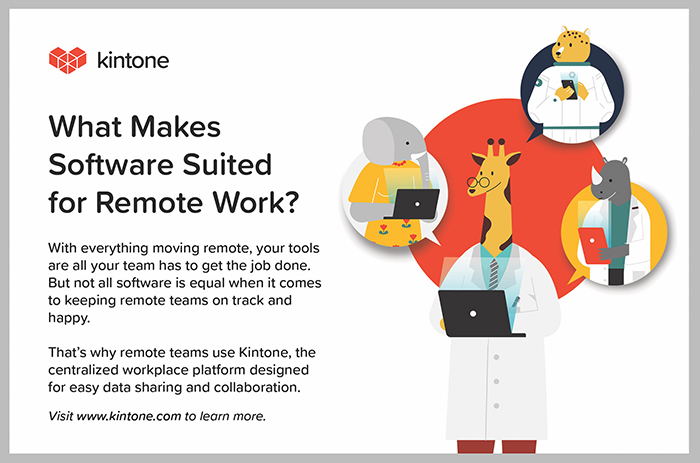Covid-19 has put a lot on the chopping block: paperwork, commercial real estate, fancy desk decorations. Some of these changes present real opportunities for a better version of work; in a world with less commuting, how much more time do we get back in our day? And some present challenges; how do working parents balance their responsibilities when their child isn’t going back to school until January?
While the pandemic has been the catalyst for change, it’s not going to be the driver of them in the long run. That would be your software.
A digital scramble for survival has left us reactive, not proactive
Offices in most major metro areas around the U.S. had little warning things were going to change in March. The call for remote work setups came to many with a 24-hour notice, forcing companies into a sudden scramble.
Which means for many of us, the move to 100% digital workspaces wasn’t strategic: it was reactive. We threw together what we could to make things work in the moment. Slack, email, Zoom, Docusign.
But the need for speed means most of our solutions for data-sharing and collaboration were not designed with a long-term game plan in mind. Which is a major problem in light of the fact that many companies will probably remain remote through 2020 and into early 2021.
You can’t stop your culture from changing, but you can influence its direction
With remote work turning into a semi-permanent state of being, it’s not just how we do things that’s shifting. Our culture is changing, too. After all, culture is built on the way we interact—and that’s been blown apart in the wake of Covid-19.
Why geographic proximity impacts culture
We all love those “have a sec?” conversations. They’re quick, effortless, and get us answers faster than any finger+keyboard combination could. Similarly, we like being able to pull people into meetings where we throw ideas and “talk it out” until we find our next steps forward.
These processes don’t just get us results—they create a culture. These experiences, over time, tell us a lot about the work world we live in. We know which coworkers we can rely on in a pinch, and which we can’t. We know who can lead a meeting and who isn’t worth inviting. We even get counter-culture culture habits; if “have a sec” conversations are common, perhaps wearing headphones becomes an easy indicator a coworker doesn’t want to be bothered.
When we go remote, we take fragments of these experiences with us. We still have an idea of who can lead a conversation and who can’t—but even that is subject to change when you go digital. The best in-person talkers don’t always translate well to Zoom.
The fact is, for most companies our “culture” was built firmly on the idea of physical proximity. With that gone, the culture goes with it—or begins to change into something new.
Why software will drive your new culture
Now that we’re all working remote, we depend on our software and digital tools to stay connected, both as people and as members of a shared project or task. They’re the only lifeline between us and our coworkers, leaders, vendors, and clients.
Which means our digital tools will play a direct role in every collaboration experience we have. But this can be a problem if we don’t fully understand how these tools are impacting us.
Two major challenges presented by the move to digital workspaces
The first is the lack of transparency digital tools create. Most modern-day collaboration tools allow employees to have conversations that aren’t accessible or visible to other members of the team.
Let’s give an example: employees Allison and Daiki see a problem with an upcoming webinar they’re supposed to run. Allison pings Daiki on his private Slack, and the two talk out the problem and its potential solutions. Satisfied with their conclusions, they act to implement them.
While this seems efficient, there are a few problems:
- Because the conversation was held behind digital closed doors, it means there’s not a chance for anyone else to learn from or build upon the issues discussed in it. This can result in other members of the team having the same conversation over (they had no idea it was already discussed) or later feeling blindsided by change requests that come without context.
- Because the conversation is not accessible to anyone besides the two people involved, there’s no chance for others to learn from it. Only Allison and Daiki (unless they decide to re-hash their entire conversion on a Zoom meeting or other, more public channel) know how to identify this problem and develop solutions for it. This not only creates information hierarchies, it also means that the company can lose that kind of insight process if Allison or Daiki ever leave the company.
These small violations of transparency, even when pursued with good intentions, contribute to a culture of isolation. People feel cut out from the conversations that matter; they feel they don’t have context or a big-picture view of their work; they feel as if they have less control over the way things play out (because they had no chance to give input during the discussion phase).
The second challenge is towards a culture of openness. We live in a world where liability is more imperative than ever, and many people are under the sentiment that HR is there to cover the company at the expense of employees. In a pre-digital world, people side-stepped this with face-to-face, “off the record” conversations with one another. In a digital world, many people are realizing that kind of freedom is no longer possible, and that everything they say can—and mostly likely will be—on record.
On one hand, this shift to accountability is a good thing: it encourages people to be open and honest about what they think and stand by what they say. But on the flip side, if a work culture isn’t set up to encourage and embrace diversity of views and thoughts, the result isn’t more openness, it’s less.
People will always have their concerns and grievances and ideas about how to improve the company, teamwork, and projects. But if they feel the expression of these could put them on the chopping block, they’re either going to internalize them (which leads them to fester) or find hidden ways of expressing them to trusted colleagues. Perhaps a non-recorded Zoom call, or direct chats on Instagram. Certainly not on email or any of the “open” Slack channels where the company could see and potentially use their feelings against them.
A working mom who feels burnt out from 8 AM meetings while juggling two stay-at-home kids may feel she risks her employability if she openly talks about how difficult her position is.
A young employee who feels her ideas aren’t valued by her manager certainly won’t post about it where her boss can see.
These employees will find ways to connect with like-minded people—but they’ll be through hidden, non-official work channels. Which means HR won’t be able to learn from these struggles and improve the culture as a result of them.
Digital tools foster accountability, but they put strain on openness if they’re not paired with a culture of receptiveness without punishment.
How can HR counter these kinds of digital-driven culture issues?
In the case of transparency, by centralizing as much communication as much as possible while creating policies around how channels should be used. Employees will have an easier time tracking conversations, project changes, and other news if they don’t have to search Slack/Email/Zoom/Google to see them.
- Start by examining which collaboration tool offers both high levels of transparency and the ability for department-level, topic, or task-specific conversation. Ask teams what they like and dislike about the tools they use, and what problems they face using them. Don’t let choices of speed of implementation from earlier this year continue to create new problems for employees.
- In the case of openness, it’s less about changing your tools and more about realizing what kinds of pressure these new digital tools place on employees. Software changes more than just the way we share information.
- Work with employees to identify how their tools and digital workspace impact how they view their role on an individual and company-wide level. Do they still see themselves as a part of the team? Or has their view changed with continued isolation?
- When it comes to openness, creating channels or avenues for people to express themselves (not just to HR but also to their coworkers) goes a long way. A working mom will feel more connected to her team and more loyal to her employer if she can share her experiences with other parents in the company and then (as a group) express those experiences to her company in order to improve everyone’s work environment. But this comfortability begins with fostering open conversations—and letting employees have messy and sometimes uncomfortable conversations at the onset.
Learning from a company that’s been there before
The challenges of transparency and openness we’ve discussed are problems we at Kintone have personally faced—and resolved with the help of our digital platform (also called Kintone).
Who are we? We’re a Bay Area startup of 50 employees who went remote in 24-hours without a hitch when San Francisco’s shelter-in-place order came on March 16th. We’re also the subsidiary of Cybozu, Inc., a Japanese company of 500+ employees and $1B market value that went fully remote on February 24th with similar ease.
Rather than struggle during the pandemic, we’ve thrived. And we’ve been able to do some surprising things along the way when it comes to transparency and openness. As a result of using Kintone, we’ve been able to keep almost all of our conversations visible so everyone, regardless of department or rank, better understands our company, our mission, and our values. This includes things like how bonuses are calculated, employee’s 401k benefits, and our plans for the San Francisco office in the future.
But we wouldn’t be able to be this transparent without our culture of openness. At Kintone, we believe in “diversity of thoughts and opinions.” It’s this, combined with a culture of improvement rather than blame when things go wrong, that allow us to keep our conversations honest, even when they’re uncomfortable.
If you’d like to learn more about what Kintone can do for HR teams who are facing their own remote work challenges, check out our ebook, “How New Technologies & Methodologies Are Reshaping HR.” Or if you want to explore how your company can use Kintone’s tried-and-true methods to improve the remote work experience, visit our remote work resources page.

